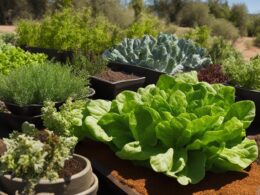Are you looking for effective ways to conserve moisture, enrich your soil, and promote plant growth in your drought-resistant garden? Look no further than organic mulches! These natural materials, such as leaves, twigs, and plant debris, are not only great for retaining moisture but also provide essential nutrients to your plants and beneficial soil organisms. By mulching your garden, you can improve soil structure, control soil pathogens, and enhance water absorption, all while creating a cost-effective and low-maintenance landscape that thrives in dry climates.
Key Takeaways:
- Organic mulches are beneficial for drought-resistant gardens as they conserve moisture and enrich the soil.
- Mulching promotes plant growth by providing essential nutrients to plants and beneficial soil organisms.
- Organic mulches improve soil structure, control soil pathogens, and enhance water absorption.
- Mulching is a cost-effective and low-maintenance solution for creating landscapes that thrive in dry climates.
- By utilizing organic mulches, you can preserve soil moisture, enhance soil fertility, and reduce the need for excessive watering.
Benefits of Mulching for Drought-Resistant Gardens
Mulching provides several benefits for drought-resistant gardens. Firstly, it helps prevent weed growth by reducing the amount of sunlight reaching weed seeds. This natural weed control method reduces the need for chemical herbicides and prevents competition for water and nutrients among plants.
Secondly, mulching conserves water by reducing evaporation from the soil surface. By acting as a protective barrier, mulch helps retain moisture in the soil, allowing plants to access it for a longer period of time. This not only reduces the frequency of watering but also promotes deeper root growth, increasing the drought tolerance of plants.
Additionally, mulch protects the soil from various environmental factors. It acts as a shield, preventing soil erosion caused by heavy rain or irrigation. Mulch also helps regulate soil temperature, keeping it cooler in hot weather and warmer in cold weather. This temperature regulation is particularly beneficial for plants that are sensitive to extreme temperatures. By creating a stable soil environment, mulching supports healthy plant growth and enhances the overall resilience of drought-resistant gardens.
| Mulch Benefits | Keywords |
|---|---|
| Weed Prevention | Organic mulches, sunlight reduction, natural weed control, chemical-free |
| Water Conservation | Moisture retention, reduced evaporation, deeper root growth, decreased watering frequency |
| Soil Protection | Erosion prevention, stable soil environment, shield against extreme temperatures |
| Temperature Regulation | Cooler soil in hot weather, warmer soil in cold weather, enhanced plant resilience |
Types of Organic Mulches for Drought-Resistant Gardens
In drought-resistant gardens, using organic mulches can provide numerous benefits, from conserving moisture to enriching the soil and promoting plant growth. There are various types of organic mulches that are suitable for these types of gardens, each with its own unique characteristics and advantages.
Bark and Wood Chips
Bark and wood chips are popular choices for organic mulches in drought-resistant gardens. These mulches are affordable, readily available, and highly effective at suppressing weeds. They also help retain moisture in the soil by reducing evaporation. Bark and wood chips gradually break down over time, adding organic matter to the soil and improving its structure.
Grass Clippings
Grass clippings can also be used as an organic mulch option, although they decompose quickly and may become slimy if applied in thick layers. It is best to use grass clippings away from areas where you spend time, such as vegetable beds or areas near patios, as they can emit a strong odor as they decompose. Grass clippings can provide nutrients to the soil as they break down.
Straw
Straw is an ideal mulch for vegetable gardens and new lawns. It provides insulation to the soil, helping to regulate its temperature and protect it from extreme heat or cold. Straw also acts as a barrier, preventing soil-borne diseases from splashing onto plant leaves. Additionally, it deters birds and rodents from feasting on newly sown seeds, making it a valuable mulching material for seedling protection.
Garden Compost
Garden compost is an excellent option for improving soil fertility and moisture retention. It contains a rich blend of organic matter, nutrients, and beneficial microorganisms that enhance plant growth. Garden compost helps improve soil structure, allowing for better water absorption and root development. It also aids in weed suppression and reduces the need for synthetic fertilizers.
Shredded Leaves
Shredded leaves are a cost-effective and easily accessible mulch option. They provide insulation, preventing soil temperature fluctuations and reducing weed growth. Shredded leaves gradually break down, enriching the soil with nutrients and improving its structure. They are particularly beneficial for woodland or naturalistic-style gardens.
Pine Needles
Pine needles are another suitable mulch option for drought-resistant gardens. They have a natural appearance and add a decorative element to the landscape. Pine needles are especially useful for mulching around acid-loving plants like azaleas and blueberries, as they slightly acidify the soil over time. They also help suppress weeds and retain moisture.
| Mulch Type | Benefits |
|---|---|
| Bark and Wood Chips | Affordable, weed suppression, moisture retention, improves soil structure |
| Grass Clippings | Nutrient-rich, quick decomposition, weed suppression |
| Straw | Insulation, disease prevention, seedling protection |
| Garden Compost | Improves soil fertility, moisture retention, weed suppression |
| Shredded Leaves | Cost-effective, insulation, nutrient-rich, weed suppression |
| Pine Needles | Decorative, acidifies soil, weed suppression, moisture retention |
Inorganic Mulches for Drought-Resistant Gardens
While organic mulches are commonly used in drought-resistant gardens, inorganic mulches can also be a suitable option for certain landscapes. Inorganic mulches are non-biodegradable materials that do not provide nutrient benefits to the soil. However, they offer advantages such as weed suppression, moisture retention, and a decorative appearance. Let’s explore some popular types of inorganic mulches:
Rubber Mulch
Rubber mulch, made from recycled tires, is a long-lasting option that provides excellent weed suppression. It is available in various colors and textures, allowing you to create a visually appealing garden. Rubber mulch also helps conserve moisture by reducing evaporation from the soil surface.
Slate Chippings
Slate chippings are another popular choice for inorganic mulching. They add a decorative touch to the garden with their natural appearance and come in different sizes and colors. In addition to weed suppression, slate chippings allow for good drainage, reducing the risk of waterlogging in the soil.
Gravel
Gravel is a versatile inorganic mulch that offers both functionality and aesthetics. It comes in various sizes and colors, allowing you to customize the look of your garden. Gravel helps prevent weed growth, conserves moisture, and improves soil drainage. It also adds texture and depth to the landscape.
Rocks
Using rocks as an inorganic mulch can create a unique and low-maintenance garden design. Rocks come in different shapes, sizes, and colors, allowing for endless creative possibilities. They provide excellent weed suppression and help retain moisture in the soil. Moreover, rocks can act as natural heat absorbers, regulating soil temperature.
When selecting an inorganic mulch, consider the specific needs of your drought-resistant garden. Assess factors such as aesthetics, functionality, and long-term maintenance requirements.
| Inorganic Mulch Types | Benefits |
|---|---|
| Rubber Mulch | Weed suppression, moisture retention |
| Slate Chippings | Decorative, good drainage |
| Gravel | Weed prevention, moisture conservation, improved drainage |
| Rocks | Weed suppression, moisture retention, temperature regulation |
Mulching Techniques for Drought-Resistant Gardens
Mulching is a key practice for maintaining drought-resistant gardens. Proper mulching techniques can significantly enhance the effectiveness of mulch in conserving moisture, preventing weeds, and promoting healthy plant growth. Here are some essential mulching techniques to follow in your garden:
Mulch Application Thickness
The thickness of mulch applied is crucial for maximizing its benefits. Generally, a layer of mulch that is 2 to 6 inches thick is recommended, depending on the type of mulch and the plants being mulched. For trees and shrubs, a thicker layer is desirable to provide better insulation and moisture retention. In contrast, a thinner layer is suitable for flower beds and vegetable gardens to allow for better air circulation.
Mulch-Free Areas
It’s important to create mulch-free areas around the stems of plants. This prevents moisture accumulation and potential rotting of plant tissues. Leave a gap of about 2 to 4 inches around the base of each plant to allow for proper air circulation and prevent the development of fungal diseases.
Weed Barriers
Using weed barriers, such as landscape fabric, can further enhance the weed control properties of mulch. Before applying the mulch, lay the weed barrier over the soil surface, securing it with landscape pins. This will prevent weed seeds from germinating and penetrating through the mulch layer, reducing the need for frequent weeding.
Mulch Maintenance
Mulch should be regularly replenished to maintain its desired thickness. As organic mulches break down over time, they may become thinner and lose their effectiveness. It’s important to monitor the mulch layer and add a fresh layer as needed. Before adding new mulch, roughen up the decomposed mulch layer to ensure better water penetration and prevent compaction.
| Mulching Techniques | Application Thickness | Mulch-Free Areas | Weed Barriers | Mulch Maintenance |
|---|---|---|---|---|
| Benefits | 2 to 6 inches (depending on plants) | 2 to 4 inches gap around plant stems | Use landscape fabric | Regularly replenish and roughen up decomposed mulch |
Can Using Organic Mulches Help Improve Sandy Soil for Drought Resistance in Gardens?
Using organic mulches is essential for improving sandy soil drought resistance in gardens. Mulches help retain moisture, improve soil structure, and promote microbial activity, all of which are crucial for creating a more resilient soil environment. By incorporating organic mulches, gardeners can enhance their sandy soil’s ability to withstand periods of drought.
Conclusion
In conclusion, mulching is a vital practice for maintaining drought-resistant gardens. By using organic mulches, you can effectively preserve soil moisture, enhance soil fertility, and support plant growth. These mulches not only conserve moisture but also improve the quality of the soil by providing essential nutrients for plants. Additionally, inorganic mulches can be utilized for their weed suppression properties and decorative appeal.
By following proper mulching techniques, such as applying the appropriate thickness and leaving mulch-free areas around plant stems, you can maximize the benefits of mulching. This practice helps preserve soil moisture, protect the soil from erosion, and reduce the need for excessive watering. With the use of organic or inorganic mulches, you can create thriving gardens even in dry climates.
In summary, mulching offers numerous advantages for drought-resistant gardens, including soil preservation and water conservation. Whether you choose organic or inorganic mulches, incorporating mulching into your gardening routine will contribute to the overall health and resilience of your plants.











